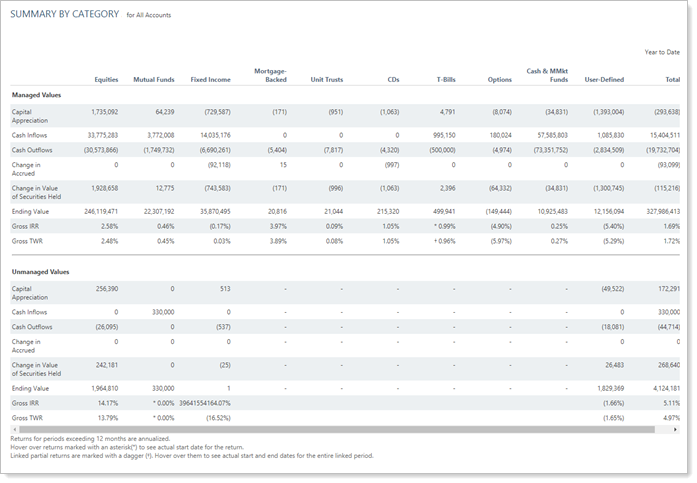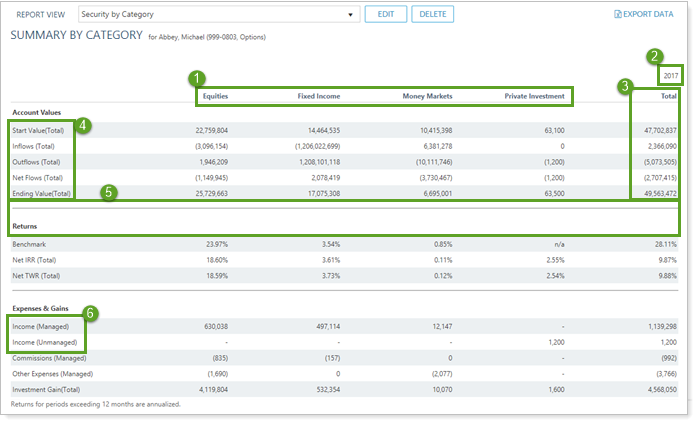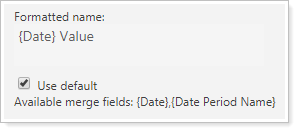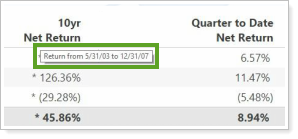 Back
Back
 Back Back |
Home > Advisor View > Reports > Dynamic and PDF Reports > Available Reports > Performance Reports > Summary by Category Report
|
Summary by Category Report
|
|
| Applies to: | |||
|---|---|---|---|
| ✔ Dynamic | Mobile |
✔ Client Portal |
|
This report aggregates performance, holdings, and transactions data to provide details about how an account or group achieved the reported returns at the category level. This report shows a breakdown of returns for specific categories alongside transaction and holdings data like inflows and outflows, income and expenses, and realized and unrealized gains and losses.
Select Use the Account Custodian As the Source of Record for Realized Gains Losses to custodian data for realized gains and losses.
The Summary by Category report gives a holistic overview of what category-level activity took place in an account or group during the date period. You can display a wide range of data points including value, flows, category benchmark, and returns for managed and unmanaged assets.

The PDF template version of this report displays six total columns, including any columns you add, such as Total, Unassigned, and Always include columns. What this means:
| Number of Columns to Include | What You Get |
|---|---|
| Account or group has less than six categories | You see all the categories listed in the PDF report. |
| Account or group has more than six categories | You see the first six categories displayed based on your sort order. The remaining categories are not displayed. |
| Account or group has five categories, and you include another column, like the Total column | All categories and the Total column are displayed. |
| Account or group has more than five categories, and you include another column, like the Total column | The first five categories and the Total column are displayed. |
These data are not available as client portal dashboard tiles.
In the Summary by Category report, versatile sorting and charting options let you answer high-level questions about accounts and groups, such as:
What did this account's Categories look like During the period? The Summary by Category report allows you to show the changes in an account or group at the category level over the period, and what caused the changes.
How do managed assets compare with unmanaged assets? Clearly break down managed and unmanaged performance and transactions into separate sections. If you want to compare them directly, you can add all the same data points for each.
Can I show clients more Detail than the Summary Report? Provide more information about how specific categories impact returns and performance to clients interested in diving deeper into their financial details.
An advisor uses a Summary report to obtain a high-level overview of account activity and performance. But he'd really like to drill down into more detail on how specific asset classes performed, while also keeping an eye on the flows for that time period.
The Summary by Category report allows the advisor to see all the Summary report data points, including returns, transactions, and flows, broken down by the asset classes for the specific account he's interested in. He adds the Total column to provide an account-level view of those data points for the same date period, adding further context to category-level data.

The Summary by Category report helps you obtain meaningful insights when evaluating category performance, transactions, and holdings. Interactive reporting features include:

Category-level reporting. See performance, transaction, and holdings results at the category level, with optional column ordering.
Uncategorized holdings are aggregated into the Unassigned column, which is included automatically. This column always appears on the right, after the individual category columns and before the Total column, regardless of Order by configuration.
This report respects account-level category overrides. For more information about category overrides, see Maintaining Accounts: The Category Overrides Page.
One date period. Unlike the Summary report, the Summary by Category report only applies to one date period.
Customizable columns.In addition to category results, the report displays securities that aren't assigned to a category aggregated in the Unassigned column. You can also add a Total column or use Always include selected categories regardless of value to manually include columns for categories, even if a particular account doesn't hold that category.
Flexible data points. Select rows to display a side-by-side comparison for the date period. Available rows include flows, returns, start and end values, capital appreciation, income and expenses, gains and losses, category and account benchmark, and more.
Customize the name of the Start Value and End Value data points on the dynamic and PDF versions of the report using merge fields to insert {Date} or {Date Period Name}. For more information on how to customize data point names, see Customize the Name of Column Headings for Reports.

Customize the Look. Use sub-headings, dividers, and blank white rows to create separate sections and draw attention to the most important data points, such as net investment gain or return numbers.
You can change the name of many rows. For more information, see Available/Selected Rows.
Show managed and unmanaged assets. Display managed, unmanaged, and total asset summary statistics side by side.
You can customize the Managed/Unmanaged labels used for the headings and captions on your reports. These changes can be made on the System Settings page.
Use the Excluded Securities Panel to designate all or some securities as unmanaged assets at the account level.
You may notice that total flows don't always match the sum of managed and unmanaged flows in some reports. This occurs when, for performance purposes, there is a flow between managed and unmanaged. When viewing the total, this flow is not needed for performance purposes and so is excluded from these aggregated numbers.
Because of this, the following flow columns may not sum to total:
|
|
Additional features include:
Control data details. If appropriate, you can choose to annualize returns and include intra-group flows.
See partial period returns. If you choose a category that only includes data for part of the date period, you can see additional details for those partial period returns.
On dynamic reports, when hover text displays for partial period returns, it will show both start and end dates. If you're using the enhanced performance calculations and there was more than one open period during the selected date range, you will see the start date of the first holding period and the end date of the final holding period.

You can easily identify linked partial period TWR and other partial period returns on your dynamic and PDF reports. A dagger symbol (†) indicates a linked partial period TWR and an asterisk (*) indicates all other partial period returns (TWR and IRR).

There is no Summary by Category dashboard widget available for the reporting dashboard.
The following settings are available for the Summary by Category report. Click the setting name for more details.
| Setting | Details | Available In... | |
|---|---|---|---|
| Dynamic Report | PDF Report | ||
| Report Name | Designate a unique name for the report view. | X | |
| Section Title | Designate what the section will be called in the PDF report. | X | |
| Theme | Designate what theme the section will use. | X | |
| Header and Footer | Choose a unique header and footer for the section or use defaults. | X | |
| Include Page Break After This Section |
Control where page breaks occur in PDF reports. |
X | |
| Account Grouping | Control grouping of accounts and groups. | X | |
| Include Reports for Closed Accounts | Choose to show sections for accounts that were closed before the report as-of date. | X | |
| Mark as Publicly Accessible | Share the report view. | X | |
| Select the date periods you want to use for the report. | X | X | |
| Use Inception Date | Report partial periods in PDF reports for instances where the account or group was opened after the beginning of the date period selected. | X | |
| Use Date or Date Period as Title | Use the date (MM/DD/YYYY) as the title of the column heading, rather than the name of the date period. | X | X |
| Category | Select which category type the report displays. | X | X |
| Always Include Selected Categories Regardless of Value | Manually add category columns that show up all the time. | X | X |
| Order By | Select what order the categories appear in. | X | X |
| Partial Returns | Choose how to mark data points that have partial returns. | X | |
| Use SMA Categories | Choose how to use the SMA categories assigned to that account. | X | |
| Annualize Returns | Report the returns as annualized returns. | X | X |
| Include Capital Gains Distributions in Realized Gain/Loss Columns | Include or exclude capital gains distributions. | X | X |
| Include Total Column | Include or exclude a column displaying account or group totals for each row. | X | X |
| Dollar Amount Precision | Choose how many decimal places you want displayed for dollar values. | X | |
| Percentage Amount Precision | Choose how many decimal places you want displayed for percentages. | X | |
| Available/Selected Columns | Choose which columns are included, in what order. | X | X |
To learn more about general dynamic reports settings, including how to customize columns, add footers, and more, see:
You can do any of the following actions with the report.
| Action | Available in Dynamic Report | Available in PDF Report | |
|---|---|---|---|
| Run Report | Run dynamic report or PDF template. | X | X |
| Edit Report | Edit report view or template. | X | X |
| Copy Report | Copy report view or template. | X | X |
| Delete Report | Delete report view or template. | X | X |
| Share Report | Share report view with other firm users. | X | X |
| Export to Excel | Export report data to a CSV file. | X | |
| Print Report | Print a dynamic report. | X | X |
| Site Themes | Edit how the dynamic report looks. | X | |
| Learn More About Customizing How PDF Templates Look | Edit how the PDF report looks. | X |